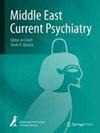Assessing the prevalence and psychological correlates of selfie addiction in Mansoura Medical School students: a cross-sectional study
IF 1.6
Q3 PSYCHIATRY
引用次数: 0
Abstract
Selfie addiction has become one of the most noticed phenomena in our modern life that is affecting people of all ages. Many researchers reported that students’ addictive selfie-taking behavior resulted in the loss of function and the development of psychological problems. In this study, we mainly targeted to calculate the prevalence of addiction of selfie at Mansoura Faculty of Medicine students and find its relationship with OCD, personality traits or disorders, and self-esteem. The study is a cross-sectional study which recruited 476 medical students through all grades. All of them are assigned to the questionnaires in the study, which included sociodemographic data, selfie addiction, Yale-Brown, Rosenberg, SCID II, and NEO scales. SCID-I scale was used to exclude students with psychotic disorder. Four-hundred seventy-six students were included in our study. Two-hundred seventy-eight (58.4%) of them showed selfie addictive behavior; most of them showed the mild degree (208 students of them) according to the used selfie scale. NPD showed strong relation with statistically significant result with selfie addiction (P-value = 0.034). Also, high self-esteem and OCD were numerically associated with selfie addiction despite lack of statistically significance (P-value = 0.366, 0.148, respectively). The prevalence of selfie addiction was 58.4% at Faculty of Medicine Mansoura University students. There was a direct proportional relationship between selfie-taking behavior with high self-esteem, OCD, and narcissistic personality disorder.评估曼苏拉医学院学生自拍成瘾的患病率和心理相关因素:一项横断面研究
自拍成瘾已经成为现代生活中最受关注的现象之一,影响着各个年龄段的人。许多研究者报道,学生上瘾的自拍行为会导致功能丧失和心理问题的发展。在本研究中,我们的主要目标是计算Mansoura医学院学生自拍成瘾的患病率,并找出其与强迫症、人格特质或障碍以及自尊的关系。本研究为横断面研究,共招募各年级医学生476名。所有参与者都被分配到调查问卷中,调查问卷包括社会人口学数据、自拍成瘾、Yale-Brown、Rosenberg、SCID II和NEO量表。采用scid - 1量表排除有精神障碍的学生。476名学生参与了我们的研究。其中278人(58.4%)表现出自拍成瘾行为;根据使用的自拍量表,大多数学生(208名)表现为轻度。NPD与自拍成瘾有显著相关性(p值= 0.034)。此外,高自尊和强迫症与自拍成瘾在数值上存在相关性,但缺乏统计学意义(p值分别为0.366、0.148)。曼苏拉大学医学院学生中自拍成瘾的患病率为58.4%。高自尊、强迫症、自恋型人格障碍与自拍行为呈正相关。
本文章由计算机程序翻译,如有差异,请以英文原文为准。
求助全文
约1分钟内获得全文
求助全文
来源期刊

Middle East Current Psychiatry
Medicine-Psychiatry and Mental Health
CiteScore
3.00
自引率
0.00%
发文量
89
审稿时长
9 weeks
 求助内容:
求助内容: 应助结果提醒方式:
应助结果提醒方式:


